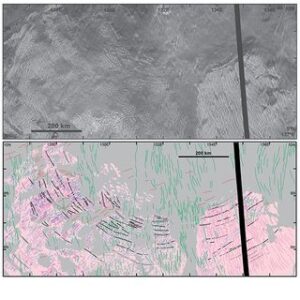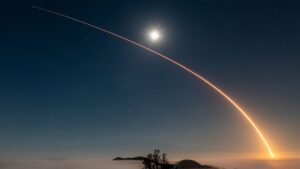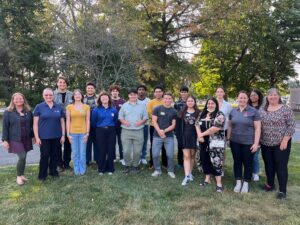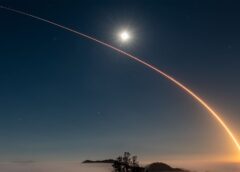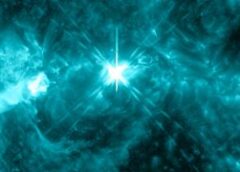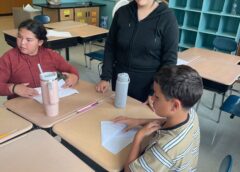Astronomers watched 35 explosive outbursts from a rare repeating “fast radio burst” (FRB) as it shifted in frequency like a “cosmic slide whistle,” blinking in a puzzling pattern never seen before. FRBs are millisecond-long flashes of light from beyond the Milky Way that are capable of producing as much energy in a few seconds as the sun does in a year. FRBs are believed to come from powerful objects like neutron stars with intense magnetic fields — also called magnetars — or from cataclysmic events like stellar collisions or the…
Read MoreNASA, Partners Continue to Advance Space Tech on Suborbital Flights
5 min read Preparations for Next Moonwalk Simulations Underway (and Underwater) New Shepard, Blue Origin’s reusable suborbital rocket, rising from the company’s Launch Site One in West Texas, on a previous flight in 2021. The vehicle returned to flight on Dec. 19, 2023, carrying payloads supported by NASA’s Flight Opportunities, enabling researchers to test disruptive solutions for space applications. Blue Origin Living and working in space requires getting ready a bit closer to Earth. Through a suborbital flight test on Dec. 19, 2023 with industry provider Blue Origin, NASA’s Flight…
Read MoreWatch Chinese astronauts get haircuts aboard Tiangong space station (video)
China’s Shenzhou 17 astronauts have been taking care of grooming alongside their on-orbit obligations. Mission commander Tang Hongbo and rookie crewmates Tang Shengjie and Jiang Xinlin recently helped each other get haircuts aboard the Tiangong space station. Video released by CMSA, China’s human spaceflight agency, shows Tang Shengjie cutting the hair of his colleague Jiang Xinlin using a smart device that also acts as a vacuum cleaner. The device sucks up hair to minimize potential risk of it clogging up the space station’s hardware. Related: How to see and track…
Read MoreNASA’s Artemis II Crew Meet with President, VP at White House
Artemis II crew members: NASA astronauts Christina Koch, left, Victor Glover, Reid Wiseman, and Canadian Space Agency (CSA) astronaut Jeremy Hansen, right, pose for a group photograph with U.S. President Joe Biden, center, in the White House Oval Office in Washington, Thursday, Dec. 14, 2023. Official White House Photo by Adam Schultz The first astronauts to fly around the Moon under NASA’s Artemis program visited the White House in Washington Thursday, and met with President Joe Biden in the Oval Office to thank him for his leadership and discuss their upcoming flight…
Read MoreHow the runaway greenhouse gas effect can destroy a planet’s habitability — including Earth’s
Using advanced computer simulations, scientists have shown how easily a runaway greenhouse effect can rapidly transform a habitable planet into a hellish world inhospitable to life. Not only does this research have implications for our understanding of extrasolar planets, or “exoplanets,” but it also offers insight into the human-driven climate crisis on Earth. The team of astronomers from the University of Geneva (UNIGE) and CNRS laboratories of Paris and Bordeaux saw that after initial stages of a planet’s climate transformation, the planet’s atmosphere, structure and cloud coverage get significantly altered,…
Read MoreArtemis II Crew Trains for Emergency Scenarios Ahead of Moon Mission
Credit: NASA/James Blair The four Artemis II astronauts practiced procedures to exit the Orion spacecraft in an emergency during training at NASA’s Johnson Space Center in Houston on Dec. 15. NASA astronaut Christina Koch (foreground) and CSA (Canadian Space Agency) astronaut Jeremy Hansen were assisted by Bill Owens, Artemis II spacesuit technician. The training included exiting both the side and top hatches of the spacecraft to ensure the crew will be ready for potential emergency scenarios upon splashdown in the Pacific Ocean that would require them to leave the capsule…
Read MoreNGC 2264: Telescopes Illuminate ‘Christmas Tree Cluster’
This composite image shows the Christmas Tree Cluster. The blue and white lights (which blink in the animated version of this image) are young stars that give off X-rays detected by NASA’s Chandra X-ray Observatory. Optical data from the National Science Foundation’s WIYN 0.9-meter telescope on Kitt Peak shows gas in the nebula in green, corresponding to the “pine needles” of the tree, and infrared data from the Two Micron All Sky Survey shows foreground and background stars in white. This image has been rotated clockwise by about 160 degrees…
Read MoreSpace weather will drag NASA’s NEOWISE asteroid-hunting probe back to Earth in 2025
After more than a decade of hunting for asteroids and comets, the days of NASA’s NEOWISE mission are officially numbered. NASA’s Jet Propulsion Laboratory in Southern California (JPL) just announced that the NEOWISE mission will come to an end within just a few years. JPL mission planners expect that solar activity will drag the space telescope out of orbit, and to a fiery death in Earth’s atmosphere, by 2025. “The mission has planned for this day a long time,” Joseph Masiero, a planetary scientist at the California Institute of Technology…
Read MoreThe rings of Uranus look positively festive in epic James Webb Space Telescope holiday photo
They may not be the gold rings from “The Twelve Days of Christmas,” but Uranus and its rings stand resplendent in this stunning portrait from the James Webb Space Telescope (JWST). It’s the second image of Uranus that the JWST has captured this year. The first, released in April, was a two-toned affair composed of imagery captured at infrared wavelengths of 1.4 and 3.0 microns. This new image adds extra wavelengths, specifically 2.1 and 4.6 microns, to give a much more complete overview of the seventh planet from the sun. …
Read MoreApproval to Exceed GSA Lodging for LPSC 2024
2 min read Approval to Exceed GSA Lodging for LPSC 2024 This letter from SARA is to issue a waiver for NASA grantees attending LPSC 2024 allowing them to be reimbursed out of their grants for their actual lodging, although it’s expected to be above the approved GSA amount. This waiver does not supersede the travel policy of your institution if it is more restrictive. Note: I have specified grants (including cooperative agreements). This may also apply to those traveling on NASA contracts, but they should communicate with their contracting…
Read More